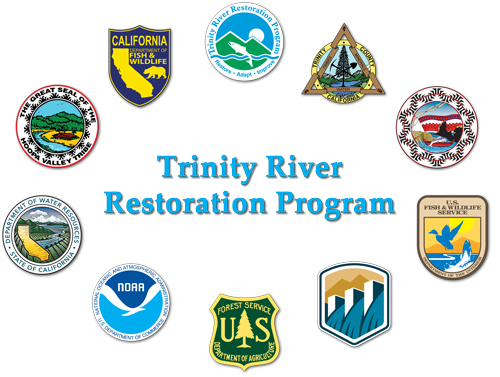The last quarterly meeting of Fiscal Year 2023 was held in Weitchpec, CA on Wednesday and Thursday last week. Typical of the start to the first days agenda, is an approval of the June meeting minutes, however this was moved to later in the day due to a request from Justin Ly [National Marine Fisheries Service] who noticed an inconsistency between how a motion had been characterized and requested time to edit prior to approval. Following this decision, the TMC requested questions and discussion of non-agenda items and then moved into TRRP program updates. The TRRP Executive Director’s report can be downloaded by clicking here.
Comments on non-agenda items brought questions from the public regarding recent social media posts of non-native/introduced fish released into the Trinity River at a rehabilitation site in Junction City. Mike Dixon, [Trinity River Restoration Program] commented that office staff saw a social media post with a bullhead catfish and noted that bullhead are introduced as a sportfish into Trinity Lake and do occur in the Trinity River. The system does not have a robust population and their chance of surviving in the conditions of the river are slim. Interestingly Kyle De Juilio [Yurok Tribal Fisheries Department] also commented that bullhead can be found in the Klamath River as conditions are suitable for them, but they are not known to persist farther up in the Trinity River system. State officials attending the meeting also commented that the State does not have a specific policy regarding introduced game fish.
There were two presentations given to the TMC before and after the lunch hour. Max Ramos [Yurok Fisheries Department] presentation titled Modeling the reestablishment of Coho salmon in Klamath River tributaries following dam removal was postponed due to illness. In his place Kiana Abel [TRRP] presented on FY23 outreach accomplishments and early FY24 outreach plans. Following the outreach presentation, the TMC heard from Dr. Greg Courtice [Applied Ecohydraulics] presented Implications for wildfire-induced fine sediment loading within the Trinity Watershed. Slides from both presentations can be downloaded here: TRRP: Event Details
Post presentations, TMC members held a blind vote to replace the TMC’s vice chair vacancy. Some shuffling with responsibilities at the US Fish and Wildlife Service opened the Board’s Chair position. According to the TMC Bylaws a Chair vacancy mid-service is to be filled by the current Vice Chair and a vote is to be held to fill the open position. The TMC voted to place National Marine Fisheries Service Representative, Justin Ly into the position, he will serve as Vice Chair and Don Bader [Reclamation] will serve as Chair until the December 2024 meeting.
The final agenda item of the first day meeting was a decision item. TMC members voted to select, Dr. Daniele Tonina of the University of Idaho to join the Scientific Advisory Board in an advertised position to focus on hydrology. To learn more about the SAB, please click here.
Day 2 of the TMC quarterly meeting started with regular business in discussing non-agenda items. Thanks were given to the Yurok Tribe for hosting the meeting. There was no request from the public to comment on non-agenda items.
Seth Naman [NOAA Fisheries] reported on the latest synthesis report on temperature in the Trinity River, Synthesizing 87 years of inquiry into Trinity River Temperatures. Please download the report here: Asarian etal (2023) Temperature Synthesis 87 years.pdf
Ken Lindke [California Department of Fish and Wildlife] led the TMC’s final presentation, Water Year 2023 initial findings and WY24 flow recommendation from the TRRP Interdisciplinary Team Work Group. The TMC considered the WY24 flow recommendation from the Flow Work Group and Interdisciplinary Team and Justin Ly [National Marine Fisheries Service] made the following motion: “to approve the IDT’s recommendation to implement winter flow variability for WY24, to timely complete the NEPA process prior to implementation, and to inform the public at least two weeks prior to moving forward with winter flow. In addition, a monitoring plan will be provided to the SAB for their review prior to winter flow variability implementation to assess the effectiveness.” The motion failed 6-2 (TMC bylaws require 7/8 affirmative votes if 8 members are present).
After a discussion of what it meant for the TMC to not send a flow recommendation for the upcoming year to the Department of Interior, Justin Ly [National Marine Fisheries Service] made a second motion to, “recommend that TMC approve beginning October 1, implement 450 cfs baseflow through October 15, then reduce baseflow to 300 cfs from October 16 to April 15.” This motion also failed. The TMC failed to pass the flow recommendation and subsequently failed to pass a motion recommending that DOI implement status-quo winter base flows, so the TMC has not yet made a recommendation to DOI. The winter flow recommendation ruleset does not change flows until December 15, so there is still time for TMC to revisit this issue and make a recommendation to DOI one way or another. If no further guidance is provided by TMC, DOI will have to evaluate its obligations under the law and determine how to proceed.
The TMC will hold their first quarterly meeting for FY24 on December 6 & 7, 2023 at the Shasta-Trinity National Forest Service office in Redding, CA.

